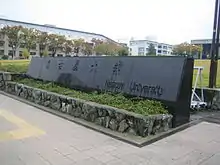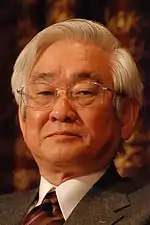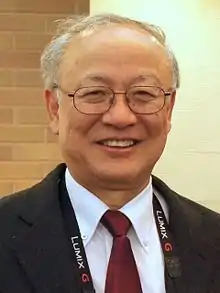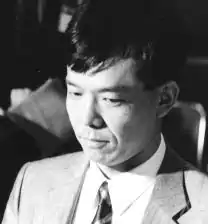Nagoya University
Nagoya University (名古屋大学, Nagoya daigaku), abbreviated to Meidai (名大) or NU,[1] is a Japanese national university located in Chikusa-ku, Nagoya. It is the last Imperial University in Japan, one of the Designated National University and selected as a Top Type university of Top Global University Project by the Japanese government. It is the 3rd highest ranked higher education institution in Japan (72nd worldwide).[2]
名古屋大学 | |
 | |
| Motto | 勇気ある知識人 (courageous intellectual) |
|---|---|
| Type | Public (National) |
| Established | Founded 1871, Chartered 1939 |
| President | Seiichi Matsuo |
Academic staff | 3,847 (2020) |
| Undergraduates | 9,585 (2020) |
| Postgraduates | 6,187 (2020) |
| Location | , , 35°09′17″N 136°58′01″E |
| Campus | Urban, 3.2 km² |
| Colors | Green |
| Mascot | None |
| Website | www.nagoya-u.ac.jp |
The University is the birthplace of the Sakata School of physics and the Hirata School of chemistry. As of 2014, six Nobel Prize winners have been associated with Nagoya University, the third most in Japan and Asia behind Kyoto University and the University of Tokyo.[3][4]
History



Nagoya University traces its roots back to 1871 when it was a temporary medical school. In 1939 it became Nagoya Imperial University (名古屋帝国大学). In 1947 it was renamed Nagoya University (名古屋大学), and became a Japanese national university. In 2014, according to the reform measures of the Ministry of Education, Culture, Sports, Science and Technology, all Japanese national universities became National University Corporation (国立大学法人). The university has a profound tradition of physics and chemistry. Many world-class scientific research achievements include Sakata model, PMNS matrix, Okazaki fragment, Noyori asymmetric hydrogenation, and Blue LED were born in Nagoya University.
In the 20th century, NU's Kuno Yasu and Katsunuma Seizō were nominated for the Nobel Prize in Physiology or Medicine, Yoshio Ohnuki was nominated for the Nobel Prize in Physics. In the 21st century, NU peoples account for half of the total number of Japanese Nobel Prize winners (up to 2014). Among the six winners of the Nobel Prize in Chemistry and the Physics, there are three professors and five alumni. The number of winners is the third among Japanese universities. In addition, the team under Professor Morishima Kunihiro participated in the Scanpyramids project by using special nuclear emulsion plates. This led to the discovery in 2017 of new chambers in the great pyramid.[5][6]
In March 2012, Nagoya University played host to the International Symposium on Innovative Nanobiodevices.[7] Three years later, NU was selected as one of the five champion universities for gender equality by the United Nations Entity for Gender Equality and the Empowerment of Women.[8]
In March 2018, Nagoya University was selected as one of top five Designated National University Corporation (指定国立大学法人). In order to become the largest national higher education corporation in Japan, the Tokai National Higher Education and Research System (国立大学法人東海国立大学機構) established by integrating with Gifu University in April 2020, both are major universities in Central Japan.
Overview
Ideal
The ideal written in the Nagoya University Academic Charter is to encourage the intelligentsia with courage by providing an education which respects independent thought. Currently, NU's academic style and characteristics are "freedom, openness, and enterprising." When Nagoya Imperial University was just established, the first president was in a passage of the Seventeen-article constitution, and his motto, "Harmony is to be valued," was the basic spirit of the entire university.[9]
Student population
While the majority of its students come from Tōkai region, Nagoya University has a good portion of students from all over Japan.
The school also has many students from abroad. Currently there are over 1300 international students (150 undergraduate) from 78 countries studying in the faculties of Nagoya University. The majority of them are from China (47%, as of May 1, 2009) and Korea (9.5%). Among other countries, Taiwan, Indonesia, Viet Nam, Malaysia, Cambodia, Sri Lanka and Uzbekistan are represented by more than 30 students. Among non-Asian countries, the United States and Brazil sent 16 students each.
Faculties and graduate schools
Faculties

- Law
- Medicine
- Engineering
- Letters
- Science
- Agriculture
- Economics
- Education
- Information Culture
Graduate schools

- Education
- Law
- Economics
- Arts and Sciences
- Science
- Mathematics
- Engineering
- Life Sciences and Agriculture
- Medicine
- International Language Culture
- International Development (GSID)
- Environmental Studies
- Information Science
The University's Research Center for Seismology, Volcanology and Disaster mitigation is represented on the national Coordinating Committee for Earthquake Prediction.[10]
Academic rankings
| Toyo Keizai National[11] | General | 21 | |
|---|---|---|---|
| Kawaijuku National[12] | General | 8 | |
| T. Reuters National[13] | Research | 5 | |
| WE National[14] | Employment | 38 | |
| NBP Hokuriku/Tokai[15] | Reputation | 1 | |
| Shimano National[16] | Selectivity | SA | |
| QS Asia (Asian Ranking version)[17] | General | 14 | |
| ARWU Asia[18] | Research | 7 | |
| QS World[19] | General | 80 | |
| ARWU World[18] | Research | 84 | |
| Social Sciences & Humanities | ||
|---|---|---|
| LAW | ||
| Asahi National[20] | Research | 4 |
| BE Success National[21] | Qualification | 12 |
| BE Pass rate National[22] | Qualification | 10 |
| ECONOMICS | ||
| RePec National[23] | Research | 13 |
| Natural Sciences & Technology | ||
| Engineering | ||
| Kawaijuku National[24] | General | 6~7 |
| QS World[25] | General | 96 |
| PHYSICS | ||
| T.Reuters National[26] | Research | 6 |
| T.Reuters World[26] | Research | 61 |
| CHEMISTRY | ||
| T.Reuters National[26] | Research | 7 |
| T.Reuters World[26] | Research | 43 |
| BIOLOGY & BIOCHEMISTRY | ||
| T.Reuters National[26] | Research | 5 |
| T.Reuters World[26] | Research | 97 |
| * T. Reuters World rankings include non-educational institutions | ||
Nagoya University is one of the most prestigious universities in Japan. This can be seen in several rankings such as the ones shown below.
General rankings
The university has been ranked 15th in 2009 and 21st in 2010 in the ranking "Truly Strong Universities" by Toyo Keizai.[11] In another ranking, Japanese prep school Kawaijuku ranked Nagoya as the 8th best university in Japan.[12]
The Academic Ranking of World Universities (ARWU) 2009 ranks Nagoya University as fourth in Japan.[27] The 2009 THE-QS World University Rankings (From 2010 two separate rankings will be produced by the Times Higher Education World University Rankings and the QS World University Rankings) ranks Nagoya University as fifth in Japan.[28] The 2010 QS Asian University Rankings rated Nagoya number ten in Asia and number five in Japan,[29] while the QS World University Rankings[30] for 2011 ranked Nagoya 80th in the world.
Research performance
Nagoya is one of the top research institutions in Japan. According to Thomson Reuters, Nagoya is the 5th best research university in Japan.[13] Its research standard is especially high in Physics (6th in Japan, 61st in the world), Chemistry (7th in Japan, 43rd in the world), and Biology & Biochemistry (5th in Japan, 97th in the world).[31]
Weekly Diamond reported that Nagoya has the 6th highest research standard in Japan in research funding per researchers in COE Program.[32] In the same article, it's also ranked 6th in terms of the quality of education by GP funds per student.
In addition, Nikkei Shimbun on 16 February 2004 surveyed the research standards in Engineering studies based on Thomson Reuters, Grants in Aid for Scientific Research and questionnaires to heads of 93 leading Japanese research centers, and Nagoya was placed 9th (research planning ability 5th//informative ability of research outcome 9th/ability of business-academia collaboration 6th) in this ranking.[33]
Furthermore, Nagoya had the 8th highest number of patents accepted (108) in 2009 among Japanese universities.[34]
It has a high research standard in Social Science & Humanities. Asahi Shimbun summarized the amount of academic papers in Japanese major legal journals by university, and Nagoya University was ranked 4th during 2005-2009.[20] RePEc in January 2011 ranked Nagoya's Economic department as Japan's 13th best economic research university.[35]
Graduate school rankings
Nagoya Law School is considered one of the top law schools in Japan, as it was ranked 10th in the pass rate of the Japanese Bar Examination in 2010.[36]
Alumni rankings
According to the Weekly Economist's 2010 rankings, graduates from Nagoya have the 38th best employment rate in 400 major companies in Japan.[37]
Evaluation from Business World
| Ranking | |
|---|---|
| all universities in Japan | 15th[40] out of all the 744[41] universities which existed as of 2006 |
| Source | 2006 Survey[40] by Weekly Diamond 〈ja〉 on the ranking of the universities which produced the high ratio of the graduates who hold the position of "president and chief executive officer of listed company" to all the graduates of each university |
Notable alumni and affiliates
- Full list can be found in the Japanese Wikipedia article: List of Nagoya University people (in Japanese)
Physics and Materials
 Shoichi Sakata (坂田 昌一), a physicist, known for theoretical work on the subatomic particles (Sakata model), Nobel Prize in Physics nominee.
Shoichi Sakata (坂田 昌一), a physicist, known for theoretical work on the subatomic particles (Sakata model), Nobel Prize in Physics nominee.

 Isamu Akasaki (赤崎 勇), one of the 2014 Nobel Prize in Physics for inventing the blue LED.
Isamu Akasaki (赤崎 勇), one of the 2014 Nobel Prize in Physics for inventing the blue LED. Hiroshi Amano (天野 浩), one of the 2014 Nobel Prize in Physics for inventing the blue LED.
Hiroshi Amano (天野 浩), one of the 2014 Nobel Prize in Physics for inventing the blue LED.
- Yoshio Ohnuki (大貫 義郎), a physicist, 1955-56 Nobel Prize in Physics nominee.
- Hiroomi Umezawa (梅沢 博臣), a physicist, known for his fundamental contributions to quantum field theory.
- Yasushi Takahashi (高橋 康), a physicist, known for the Ward–Takahashi identity.
- Bunji Sakita (崎田 文二), a physicist, one of the discoverers of supersymmetry.
- Sumio Iijima (飯島 澄男), a physicist, inventor of carbon nanotubes.
- Akira Tonomura (外村 彰), a physicist, for his development of electron holography
- Toshio Matsumoto (松本 敏雄), an astronomer, Professor Emeritus of JAXA.
- Morinobu Endo (遠藤 守信), a physicist and chemist, pioneers of carbon nanofibers and carbon nanotubes synthesis.
Chemistry and Biology
 Koji Nakanishi (中西 香爾), a Japanese-American bioorganic and natural products chemist, graduated from Nagoya, professor at Columbia University.
Koji Nakanishi (中西 香爾), a Japanese-American bioorganic and natural products chemist, graduated from Nagoya, professor at Columbia University. Ryōji Noyori (野依 良治), one of the 2001 Nobel Prize in Chemistry winners, spent most of his academic career researching and teaching at the university.
Ryōji Noyori (野依 良治), one of the 2001 Nobel Prize in Chemistry winners, spent most of his academic career researching and teaching at the university. Osamu Shimomura (下村 脩), one of the 2008 Nobel Prize in Chemistry for green fluorescent protein (GFP).
Osamu Shimomura (下村 脩), one of the 2008 Nobel Prize in Chemistry for green fluorescent protein (GFP). Yoshito Kishi (岸 義人), Morris Loeb Professor of Chemistry at Harvard University.
Yoshito Kishi (岸 義人), Morris Loeb Professor of Chemistry at Harvard University. Tohru Fukuyama (福山 透), an organic chemist and Professor of Chemistry at the University of Tokyo.
Tohru Fukuyama (福山 透), an organic chemist and Professor of Chemistry at the University of Tokyo.
- Kuno Yasu (久野 寧), a physiologist, 1936, 1938, 1953 Nobel Prize in Physiology or Medicine nominee.
- Yoshimasa Hirata (平田 義正), an organic chemist, known for "Hirata-school" in Japan.
- Reiji Okazaki (岡崎 令治), Pioneering molecular biologists, discoverer of the Okazaki fragments, graduated from Nagoya and were both professor at the university.
- Tsuneko Okazaki (岡崎 恆子), Pioneering molecular biologists, discoverer of the Okazaki fragments, graduated from Nagoya and were both professor at the university.
- Hisashi Yamamoto (山本 尚), a Japanese chemist, laureate of the Medal of Honor with a Purple Ribbon.
- Masatoshi Takeichi (竹市 雅俊), a Japanese cell biologist, 2005 Japan Prize winner.
Mathematic
 Shigefumi Mori (森 重文), one of the 1990 Fields Medalists, spent most of his academic career at the university until he won the Fields Medal in 1990.
Shigefumi Mori (森 重文), one of the 1990 Fields Medalists, spent most of his academic career at the university until he won the Fields Medal in 1990.
- Masayoshi Nagata (永田 雅宜), a Japanese mathematician, disproved Hilbert's fourteenth problem.
- Goro Azumaya (東屋 五郎), a Japanese mathematician, introduced the notion of Azumaya algebra.
- Masatake Kuranishi (倉西 正武), a Japanese mathematician, established the Cartan-Kuranishi Theorem.
- Tomio Kubota (久保田 富雄), a Japanese mathematician.
- Takashi Ono (小野 孝), a Japanese mathematician.
More notable alumni
- Tang Jun, President and CEO of Xin Hua Du Industrial Group Co.
- Uichiro Niwa - Japanese Ambassador to China, former Chairman and President of Itochu, former CEO of Japan Post Holdings
- Shoichiro Toyoda - Ex-CEO of Toyota Motor
References
- Tokyo's Meiji University's 明大 is pronounced identically
- Academic Ranking of World Universities (2015).
- http://en.nagoya-u.ac.jp/people/nobel/index.html
- https://www.nobelprize.org/nobel_prizes/physics/laureates/2014/press.html
- http://en.nagoya-u.ac.jp/research/activities/news/2017/11/Physicists-at-Nagoya-University-discover-a-huge-void-in-Giza's-Great-Pyramid.html
- http://www.aip.nagoya-u.ac.jp/en/public/nu_research/features/detail/0004136.html
- ISIN 2012 Archived 2012-02-07 at the Wayback Machine. Square.umin.ac.jp. Retrieved on 2014-06-16.
- UN Women announces bold commitments to gender equality from 10 partners across the world | UN Women – Headquarters
- 名大史ブックレット6 草創期の名古屋大学と初代総長渋沢元治
- Organizations with ties to CCEP CCEP, accessed 2011-03-19
- "Truly Strong Universities" (in Japanese). Toyo Keizai. 2010. Retrieved April 29, 2011.
- "Kawai 30 Top Japanese Universities". Kawaijuku. 2001. Retrieved April 29, 2011.
- "Thomson Reuters 20 Top research institutions in Japan". Thomson Reuters. 2011. Retrieved April 29, 2011. (this raking includes 5 non-educational institutions)
- "Employment rate in 400 major companies rankings" (in Japanese). Weekly Economist. 2011. Retrieved April 29, 2011.
- "Nikkei BP Brand rankings of Japanese universities" (in Japanese). Nikkei Business Publications. 2010. Retrieved April 29, 2011.
- "GBUDU University Rankings" (in Japanese). YELL books. 2009. Retrieved April 29, 2011.
- "QS Asian University Rankings". QS Quacquarelli Symonds Limited. 2016. Retrieved September 24, 2017.
- "Academic Ranking of World Universities". Institute of Higher Education, Shanghai Jiao Tong University. 2017. Retrieved September 24, 2017.
- "QS World University Rankings". QS Quacquarelli Symonds Limited. 2018. Retrieved September 24, 2017.
- Asahi Shimbun University rankings 2010 "Publification rankings in Law (Page 4)" (PDF) (in Japanese). Asahi Shimbun. 2010. Retrieved May 11, 2011.
- "Bar Exam Successful Applicants rankings" (in Japanese). Shikaku Seek. 2010. Retrieved May 11, 2011.
- "Bar Exam Pass rate rankings" (in Japanese). Shikaku Seek. 2010. Retrieved May 11, 2011.
- "Top 25% Institutions and Economists in Japan, as of January 2011". REPEC. 2011. Retrieved May 11, 2011.
- "Kawaijuku japanese universities rankings in Engineering field" (in Japanese). Kawaijuku. 2012. Retrieved July 20, 2012.
- "QS topuniversities world rankings in Engineering field". Topuniversities. 2012. Retrieved July 20, 2012.
- "Thomson Reuters 10 Top research institutions by subject in Japan" (in Japanese). Thomson Reuters. 2010. Retrieved May 11, 2011.
- Archived February 10, 2010, at the Wayback Machine
- Archived November 10, 2009, at the Wayback Machine
- University Rankings Archived 2010-05-16 at the Wayback Machine. Top Universities. Retrieved on 2014-06-16.
- QS World University Rankings - 2011 Archived 2011-09-30 at the Wayback Machine. Top Universities (2012-12-19). Retrieved on 2014-06-16.
- "Thomson Reuters 20 Top research institutions in Japan" (in Japanese). Thomson Reuters. Archived from the original on 2011-06-13. (this raking includes non-educational institutions)
- "週刊ダイヤモンド" ダイヤモンド社 2010/2/27 http://web.sapmed.ac.jp/kikaku/infomation/0227daiyamondokiji.pdf
- 大学工学部研究力調査(04.2.22) Archived 2015-05-07 at the Wayback Machine. Homepage3.nifty.com. Retrieved on 2014-06-16.
- (in Japanese)2009年国内大学別特許公開件数 Archived 2011-05-23 at the Wayback Machine, Japanese patent office, accessed May 3rd 2011
- Within Country and State Rankings at IDEAS: Japan. Ideas.repec.org. Retrieved on 2014-06-16.
- 2010年(平成22年)新司法試験法科大学院別合格率ランキング -法科大学院seek. Laws.shikakuseek.com. Retrieved on 2014-06-16.
- "Employment rate in 400 major companies rankings" (in Japanese). Weekly Economist. 2011. Retrieved Apr 29, 2011.
- e.g. Yoyogi seminar published Hensachi (the indication showing the entrance difficulties by prep schools) rankings "Archived copy". Archived from the original on 2011-04-22. Retrieved 2011-04-28.CS1 maint: archived copy as title (link)
- Japanese journalist Kiyoshi Shimano ranks its entrance difficulty as SA (most selective/out of 11 scales) in Japan. 危ない大学・消える大学 2012年版 (in Japanese). YELL books. 2011.
- Weekly Diamond The ranking of the universities which produced the high ratio of the graduates who hold the position of "president and chief executive officer of listed company" to all the graduates of each university(in Japanese)
- The number of universities and students|National Universities Association(in Japanese)
External links
| Wikimedia Commons has media related to Nagoya University. |
- The Nagoya University English website
- Nagoya Repository - collection of scholarly papers and dissertations by the faculty and students of Nagoya University.
- Information about the English-taught Full Degree Program
- Courses offered in English .